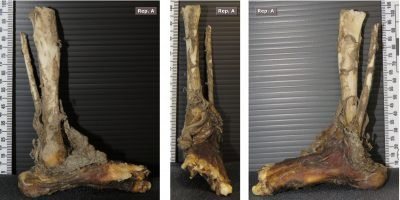What Happaned?
In May 2019, a passer found inside an agricultural plot, some small unknown bone, scattered (and partly buried) over a large land area. Upon assignment by the Judicial Authority, these finds were subjected to technical-specialist investigations to determine if they were of human origin.

Most of the remains were found of animal origin but this “foot” was controversial
CT with reconstruction


How 3D printing was useful?
The exhibits analyzed, characterized by a state uneven conservation, included: distal portions of a limb inferior, consisting of the tibia, fibula, and bones of the rear foot, with mummified fabrics (Exhibit TO); scapula (Rep. B); some vertebrae (Rep. C); left hemi jaw (Rep. D); ulna and radio (Rep. E); The morphological peculiarities of exhibit A have requested the execution of radiological insights (CT with 3D reconstruction, Fig. 1 and 2). A thin section of fabric was made of bone from a fragment of the tibia, for microscopic observation. In the end, a reproduction was made in plaster with the 3D printer (thanks to the collaboration with the 3D Printing Lab for Surgery of 3D4MED), to facilitate the comparisons with collections of skeletons at museums of human and veterinary anatomy.


RESULTS
Almost all of the finds resulted from non-human nature at first glance macroscopic. The “foot“, on the other hand, had controversial characteristics, raising doubts about the possible belonging to an infant. The radiological investigations allowed to highlight as none of the segments bones had growth nuclei. By skeleting the various elements of Rep. A some anatomical subtleties have been observed. At histological investigations, they showed some features usually don’t present in human bone tissue, but however not direct (Fig. 3 and 4)

Figure 3
Figure 4
CONCLUSION
An accurate forensic anthropological investigation, assisted by instrumental radiological and histological examinations, has allowed excluding the human nature of all the elements found and of claim that they probably belonged to the same animal, despite the uneven state of conservation of the finds. It has been hypothesized that the bone remains belonged to a carnivorous plantigrade animal, most likely to one stone marten or a weasel, native species in the area of discovery.

M. Morettia , A. Manfredib , D. Radaellib , V. Bolcato a , B. Bertoglio a , S. D. Visonà a , A. M. M. Osculati a aDipartimento di Sanità Pubblica, Medicina Legale e Forense, Unità di Medicina Legale e Scienze Forensi “A. Fornari”, Università di Pavia bDipartimento Universitario Clinico di Scienze Mediche Chirurgiche e della Salute, Struttura Complessa di Medicina Legale, Università degli Studi di Trieste


